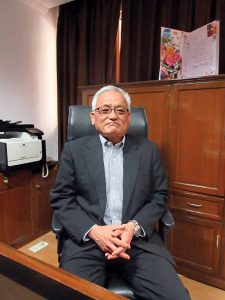By localising the Global Series (GS) platform, Sml Isuzu is aiming at a higher market share in India.
Story by:
Anirudh Raheja
SML Isuzu has begun selling the Global Series of light and medium-duty trucks that it unveiled at Auto Expo 2018. Flaunting new cabins, the trucks reflects on the company’s strategy to increase market share in India. Leveraging Isuzu’s global experience and design philosophy, the Global Series trucks include the Samrat (GS) HD19, Sartaj (GS) turbo-CNG, Samrat (GS) tipper, Samrat GS, Super GS, Supreme GS, Prestige GS, Sartaj (GS) HG 72, Sartaj (GS) 59XM and Sartaj (GS) 5252XM. They range from 5.9-tonne to 10.25-tonne, and offer many new and interesting
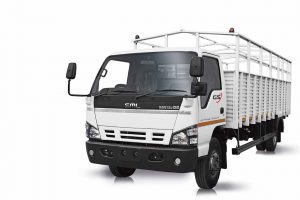 elements apart from the new cabins. Engineered to address the changing needs of operators, the new cabins make for a modern and elegant appearance. If they provide a hint of the change that is taking place at SML Isuzu at various levels, including manufacturing, the development and launch of the Gobal Series trucks also points at utilising global expertise to enhance the local touch.
elements apart from the new cabins. Engineered to address the changing needs of operators, the new cabins make for a modern and elegant appearance. If they provide a hint of the change that is taking place at SML Isuzu at various levels, including manufacturing, the development and launch of the Gobal Series trucks also points at utilising global expertise to enhance the local touch.
Global expertise, local touch
The feasibility study for the Gobal Series begun five years back. An important part of the exercise was to understand the market requirements. The objective, said Eiichi Seto, MD & CEO, SML Isuzu, was to adapt the Global Series to the Indian industry needs. Stress from the beginning was on achieving high levels of localisation. The aim was set to achieve 100 per cent localisation. Except for some special components necessary to meet BSIV emission norms, everything else on the Global Series trucks is locally sourced thus. To ensure no compromise in standards was done, Isuzu stationed two engineers at SML Isuzu plant (at Ropar). “They (the two engineers) overlooked the complete development of the platform and the preparation of vehicles for the market,” revealed Seto San. Supporting the two engineers were a number of visiting engineers from Isuzu to ensure quicker and complete localisation. Technical meetings with Isuzu and the company’s promoter Sumitomo, Japan, were held every quarter.
Sporting a new grille and clear lens head lamps, the Global Series trucks are built on a thoroughly reworked chassis. It is stronger and more robust, most of all, it is locally sourced, and forms the basis for the new cabin. If the adequate gap between the engine and the cabin for better air circulation helps the engine to operate at a lower temperature, the air cleaner has been moved to the right. “In India, there is a lot of dust by the road side. By moving the air cleaner to the right, the suction of dust into it has reduced. This has had a positive effect on the fuel efficiency,” mentioned Seto San. The new cabin has enabled the engineers to ensure ergonomic excellence. The instrument panel has been developed, and is part of the CAN-bus network. A part of the instrument panel is an electronic multi-function display that shows vehicle data along with fault codes and errors. As per the government mandate, the cabins of Global Series trucks incorporate air blower units in their cabins. Air-conditioning is offered as an option. The announcement to
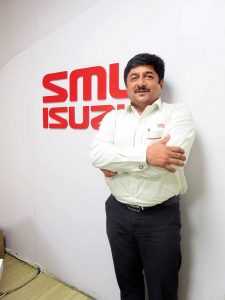 fit a blower delayed the start of the production of the Global Series trucks. Informed Seto San, “The official notification for air blowers was issued in November 2017 and implemented from January 2018. We had to delay mass production of Global Series to incorporate the change. Production resumed from March 2018. We now have an inventory that will help us to address the market requirements.” Except for special vehicle requirements like four-wheel drive ones or a 12.9-tonne vehicle for example, which require different component types, SML Isuzu, by the end of this year, will introduce the entire Global Series trucks ranging between five and 10-tonnes.
fit a blower delayed the start of the production of the Global Series trucks. Informed Seto San, “The official notification for air blowers was issued in November 2017 and implemented from January 2018. We had to delay mass production of Global Series to incorporate the change. Production resumed from March 2018. We now have an inventory that will help us to address the market requirements.” Except for special vehicle requirements like four-wheel drive ones or a 12.9-tonne vehicle for example, which require different component types, SML Isuzu, by the end of this year, will introduce the entire Global Series trucks ranging between five and 10-tonnes.
GS philosophy for bus business
SML Isuzu is extending the Global Series philosophy to the bus business as well. Work has already begun on tweaking the chassis of the bus models, and emphasis is being laid on them meeting the market requirements in terms of functionality and aesthetics. Exporting close to 800 units annually to SAARC markets like Nepal, Bangladesh, Sri Lanka and Bangladesh, SML Isuzu is very keen to grab a larger pie of the home market. Of the opinion that the domestic market offers strong potential for growth, Seto San mentioned that they have set a target of having 180 points by the end of next year. “We currently have 160 service points,” he averred. Commissioned regional training centres at Kolkata and Bengaluru each, the CV maker, through the three regional centres (there’s already one at Ropar), will conduct two-to-three courses for skill upliftment of its service
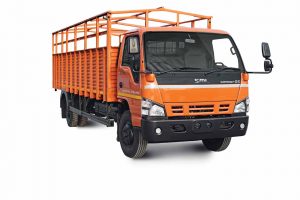 personnel. It has been training 1000 contracted road side mechanics for BSIV vehicles. “This will help us to extend our reach, and especially because BSIV vehicles contain costly components,” informed Seto Sun.
personnel. It has been training 1000 contracted road side mechanics for BSIV vehicles. “This will help us to extend our reach, and especially because BSIV vehicles contain costly components,” informed Seto Sun.
In anticipation of the changes, SML Isuzu has increased the count of R&D engineers from 70 to 100 over the last two years. Careful enough to not abruptly thrust upon the changes, SML Isuzu is providing a lead time. Mentioned Seto San, “Movements that follow a time frame will allow us to draft our investment policies accordingly.” Driving the development of BSVI vehicles, the company is also gauging the readiness
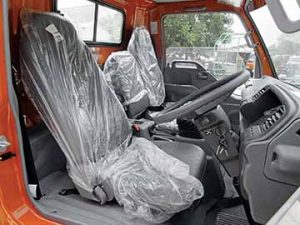 of the market for advanced technologies. “Since the country needs to spend a hefty amount to import technology import to meet the needs – of the market and regulatory, it is necessary to be able to offer local solutions,” mentioned Nawal Kumar Sharma, General Manager, Corporate Marketing and CRPM, SML Isuzu. Seto San quipped, “Technologies like EBD, AMT and ABS have a cost involved. They also have a utility value. If the customer is willing to pay for it, we will give it to him.” On Global Series trucks, the company is offering SML Saarthi telematics system (developed in association with Minda iConnect) as standard. The system will feature dashboard analytics and real-time vehicle location, and will play an important role in vehicle maintenance.
of the market for advanced technologies. “Since the country needs to spend a hefty amount to import technology import to meet the needs – of the market and regulatory, it is necessary to be able to offer local solutions,” mentioned Nawal Kumar Sharma, General Manager, Corporate Marketing and CRPM, SML Isuzu. Seto San quipped, “Technologies like EBD, AMT and ABS have a cost involved. They also have a utility value. If the customer is willing to pay for it, we will give it to him.” On Global Series trucks, the company is offering SML Saarthi telematics system (developed in association with Minda iConnect) as standard. The system will feature dashboard analytics and real-time vehicle location, and will play an important role in vehicle maintenance.
Time to market
The migration to BSIV also affected SML Isuzu. The company turned into a positive opportunity by building capacity. Of the opinion that the government should give time for planning and in-house development of technologies to boost local manufacture, Seto San mentioned, “A lot of sensors will be involved in the operation of BSVI system. It would also include an exhaust gas temperature system. The cost of this system could be more than the cost of the engine.” Stating that the cost of SCR system is high due
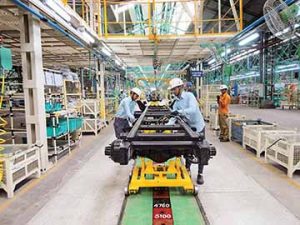 to the chemical treatment agents involved, Seto San explained that EGR coolers and valves are required on the engine side to meet BSVI emission norms as much as the SCR system (with DPF) is necessary to meet BSVI norms on the exhaust side. Collaborating with major component suppliers locally, SML Isuzu is observing the push for electrification. “Because the return on investment is questionable, suppliers are feeling the heat even as they think of investing in BSVI.
to the chemical treatment agents involved, Seto San explained that EGR coolers and valves are required on the engine side to meet BSVI emission norms as much as the SCR system (with DPF) is necessary to meet BSVI norms on the exhaust side. Collaborating with major component suppliers locally, SML Isuzu is observing the push for electrification. “Because the return on investment is questionable, suppliers are feeling the heat even as they think of investing in BSVI.
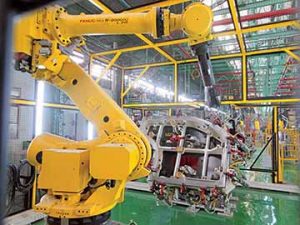 The thrust of central government on electro-mobility is hampering the trust of suppliers to invest in BSVI, opined Seto San.” Necessitating the use of sophisticated technology, BSVI emission norms will make it essential for the supply of good quality fuel and infrastructure for AdBlue.
The thrust of central government on electro-mobility is hampering the trust of suppliers to invest in BSVI, opined Seto San.” Necessitating the use of sophisticated technology, BSVI emission norms will make it essential for the supply of good quality fuel and infrastructure for AdBlue.
The industry trend of higher tonnage shift is one of the various elements that SML Isuzu is keeping a close tab on. Confident that growth will keep company since a lot of pre-buying is expected to take place before BSVI emission norms kick-in, Seto San mentioned that they are waiting and watching. With vehicle costs set to rise with every new regulation implemented, SML Isuzu is focusing on upgrading its range of products with a hope to gather a bigger pie of the Indian market. Buoyant about infrastructure and e-commerce growth, Seto San is confident of certain segments like reefer trucks growing faster than others. Pointing at the change in the way people buy vegetables, and in the way buying habits have changed, Seto San mentioned that the government is giving huge subsidies to develop cold chain infrastructure. He concluded, “We are confident of the Global Series trucks addressing the requirements of operators in existing as well as new, emerging segments
like reefer, agriculture and ecommerce.”
Eiichi Seto, MD & CEO, SML Isuzu
Q. What new do the Global Series trucks offer?
A. Except for some special components related to BSIV emission compliance, which are not yet manufactured in India, almost 100 per cent of the components (aggregates) that make the Global Series of trucks are locally sourced. They are ‘Made in India’. The new, ergonomic cabin that the Global series trucks feature are also made from locally sourced components. The new cabins mark a change after three decades. To be honest, we did not change our truck cabins for three decades. We therefore decided to launch new truck cabins based on the requirements of our customers in consultation with our promoters and partners Isuzu. We started a feasibility study almost five years ago on the kind of cabin that would be suitable for this market. After finalisation of the cabin, we started preparation for their production and introduction. Since all our competitors are Indian, it was necessary that we localise all the components. This took a bit more time than expected.
Q. What changes were necessitated at the manufacturing level?
A. Two Isuzu engineers were stationed at the Ropar plant during the development and preparation (of Global Series). Since it was the first instance, the two engineers were assisted by numerous visiting engineers. Regular meetings were held every quarter with Isuzu and our promoters Sumitomo, Japan. We localised all the stamping and tooling parts. To understand the process, SML Isuzu engineers visited the Japanese headquarters.
Q. What are the major changes the Global Series trucks have been subjected to?
A. The cabins of the Global Series trucks have been designed by Isuzu. Modifications were done to ensure that if suited the Indian duty cycles. The instrumental panel was developed locally. It was done to align with BSIV regulation that in comparison to the standards in Japan, US or Europe. There are a lot of diagnostic functions and signage that have gone into the instrument panel. A big change is the shifting of air cleaner to the right. It was done reduce dust intake. In India, there is a lot of dust by the road side, and with the air intake on the left, the trucks tended to suck a good deal of it into the air cleaner. An air blower has been installed into the cabin. It follows the government mandate. We are offering AC as an option. The official notification for the air blower was issued in November 2017, and was implemented from January 2018. To incorporate this change, the production of Global series had to be delayed. It thus resumed in March 2018. Since then we have come to build enough inventory to satisfy customer demand. The sale of Global Series has just begun. In the Global Series, we also modified the chassis. We will also make some changes to our bus portfolio as well. We will soon have a complete new range for buses.
Q. When will you launch the entire Global Series?
A. Except for some special vehicles like four wheel drives and 12.9-tonne vehicles that require different type of components, we will launch the entire Global Series trucks range by the end of this year. They will be in the range of five to 10-tonnes. We have added one more assembly line. We have also added one more cabin assembly line. Our production capacity has gone up to 2000 trucks per shift from 1500 trucks per month. We are currently running one shift, and depending upon how steady the market is, or how it grows, we will start the second shift. Currently it is a busy season. If the market continues to remain stable, we could definitely look at two shifts a day.
Q. Did the Global Series development also necessitate any changes at the R&D level?
A. We have made fresh investments in R&D, and not just for the Global Series. We have acquired PTC design for quality improvement, and to improve the capability. Even as we expanded our production capacity, we added a new assembly line for cabin and truck chassis by investing Rs.200 crores. We did it to ensure our new global series of trucks are competitive in the Indian market. We also increased the number of engineers from 70 to 100 over the last two years. Developing BSVI vehicles on our own, the new engineers that we have hired, worked on the development of the new cabin. While the spending on R&D depends on the need, in India, the market tends to spring new regulations all of a sudden. More money than is necessary has to be spent. The lead time is often very short. I am a part of the Executive Committee of SIAM, and together with other SIAM members, have been talking to the government to provide a long term automotive vision. This would include the regulations that would be introduced. The sudden introduction of regulations is a very big issue. It is a very issue not just for us, but also for others. It is a very big issue for the entire automotive industry.
Q. There is a talk of a slew of new regulations. How do you look at the situation?
A. Every new feature has a cost involved. If the customer is willing to pay for it, we will give it to him. EBD is being talked about for trucks and buses. It will be a very costly affair. It is necessary to gauge its utility. Most of our roads have speed limits of not more than 50 kmph in the city, and 90 kmph on the highways. In such a scenario, the question is, if we require such technologies in our trucks. The trucks already have speed governors. Is the need for EBD therefore is really necessary? The decisions regarding regulations, I feel, are abrupt. The time given is so less that costs become a deterrent. The fire suppressant systems for example. Once it was introduced in vehicles to be procured by the government, there was only one agency that supplied it in India. It did so at an exorbitant rate. Over time the rate has come down to 20 per cent of the cost. What I mean is that the government should give time to plan, and to develop technologies in-house. This will also boost ‘Make in India’.
Q. FY2017-18 was a good year for the CV industry. Do you see growth sustaining?
A. I think growth will sustain. It will go up. In addition to the implementation of BSVI norms by 2020, the government is studying and actually almost issuing new notification for new truck code and bus code. These new regulations will raise the cost of the vehicle. They might be introduced in 2019, and the BSVI norms will follow in 2020. The migration to BSVI will further escalate the price. In view of this, the customer is certain to pre-buy.
Q. How is SML Isuzu looking at meeting the BSVI emission challenge?
A. There are many things that a truck requires to be EuroVI compliant. It will also require EGT system (Exhaust Gas Temperature) that costs more that the engine. A diesel CV will require more than 20 sensors, SCR, EGR and DPF. For BSIV, we have been using EGR. For BSVI, we will need to use an SCR system. It will be a combination of SCR and EGR for BSVI. On the engine side, EGR valves and coolers will be required. For EGT, SCR with DPF will be required. Work is already on at SML Isuzu for this. The cost of SCR system is very high since a lot of chemical and treatment agents are involved. It is not required to have that treatment of gases to meet BSIV emission norms. It can be easily met with EGR systems and exhaust gas treatment is not required. We of course need POC and VOC as EGT for BSIV, but that is very small. For BSVI, POC, DPF, SCR, and a lot of sensors are required. It is a very long treatment cycle to meet BSVI norms. Major components suppliers are collaborating with us. We have made a cross functional test with suppliers. We will have a very good team of suppliers.
Q. How ready are the components suppliers for BSVI?
A. As far as we are concerned, we are ready. We are on time. As far as the components suppliers are concerned, it is questionable. Last year a minister mentioned that it would be 100 per cent electric by 2030. Many BSVI components suppliers are hesitating to invest in India because they seem to figure that life of this technology is much shorter than they expect in terms of return on investment. The talk of reaching 100 per cent electric vehicle level by 2030 not being feasible is not seeming to help either. Suppliers are finding it difficult to trust. They are finding it difficult to ascertain the direction in which the industry is going. EuroVI is a very sophisticated technology. It is important to have good quality fuel and infrastructure for AdBlue.
Q. With the shift to higher tonnage, isn’t SML Isuzu looking at heavier truck segments?
A. We are studying the market and have not decided yet. If we decide, we will need a new engine. At this moment we are focusing on upgrading the range of products we offer. The market is big, and we can increase our share. We are thinking of expanding our range in the future.
Q. Infra and e-commerce are growing. Which other segments you think will grow?
A. Reefer trucks is one segment that I think will grow. The rising count of nuclear families is speeding up farm to fork travel. The need will only rise further with people having less time to store. A natural shift towards frozen products is happening. We are thus seeing growth in that segment for the last three to four years. We may soon introduce reefer vehicles. If fresh vegetable wastage has come down to 50 per cent from 75 per cent due to the entry of businesses like Reliance Fresh who ferry produce in imported refrigerated containers, we have supplied them the chassis. It was a little ahead of the time, but the results are there to see. Habits of buying fresh vegetables and produce have changed. Hypermarts and departmental stores have started replacing vegetable vendors. The agriculture supply chain segment is expected to grow faster than it did earlier. The government is also focused on developing it by giving huge subsidies to develop a cold chain. A matter of concern however is the reduction in excise exemptions under GST that were offered earlier. Power subsidies for cold storages too have been curbed.
Q. Has the bus body code fuelled demand for fully-built buses?
A. The previous bus body code was not fully implemented. It were the vehicle manufacturers who took to it rather than the bus body builders. The later can still compromise and give a cheaper product. This is putting pressure on our margins. There is a new code being contemplated which has still not been notified. With another bus body code, it will be more difficult for bus body builders to sustain in the market. The idea is that it has to be all-inclusive. I don’t understand why the government has not been able to do it as it is all about the safety of the people.
Q. International players have dominated the luxury bus market. When will the Indian players catch up?
A. The luxury bus market in India is not more than 1000 vehicles per year. The mini and midi-bus market in India is currently hovering around 45,000 units. It has the potential to grow. In our segment, we have introduced Executive LX coach. It is a small bus with luxury bus features. One of our customers, Shuttl offers bus aggregator service and we have already supplied 100 buses to it. An order for 50 buses is in the pipeline.
Q. What are your plans with the turbo-CNG bus you displayed at Auto Expo?
A. CNG buses have always been known for low performance. Our CNG buses and trucks are very well accepted in the Delhi NCR areas but since the feedback was that they were low on power, we decided to upgrade them with turbocharged engines. This is the first time in the industry that a CNG bus has been powered by a turbocharger. The turbo-CNG bus that you saw at the Auto Expo has already been homologated. It is in operation by a customer in Delhi. Homologation of other turbo-CNG products is under way. Very soon, these products will be running on the roads of Delhi. We also have a program with AC buses. Since we now have higher horsepower engines, we can now meet higher demand. Smaller buses do not require slave engines. Since bigger buses do not have a space constraint like in smaller buses, the fitment of slave engines is not difficult.
Q. You also introduced Saarthi at Auto Expo. What about its deployment?
A. We jointly developed Saarthi with Minda iConnect. It has been customised for us along with the application, and will be a standard feature across the Global Series. The electronically intensive BSIV technology made it easy to introduce as well as deploy Saarthi. Saarthi as a connected device will help the driver, the fleet owner through the program and SOS button. It will help in case of an emergency, to connect or to visit the nearest service area.
Q. About service area reach. Are you boosting your network with the introduction of Global Series trucks?
A. Every year we try to increase our touch points by up to 20 per cent. We currently have 160 service touch points. We want to increase their number to 180 by the end of next year. These will be 2S and 3S facilities. We have opened two regional training centres at Kolkata and Bengaluru each. One centre at our plant at Ropar is operational already. Every month we conduct two to three courses for uplifting the skills. We train every mechanic in our dealerships for BSIV and some of the contracted road mechanics too. They currently amount to more than 1000 in number. We are a bit cautious with BSIV because training our roadside mechanics to service BSIV vehicles and sending our customers to them may cost us components which are quiet expensive.
Q. What about the push for alternate fuel vehicles?
A. The potential for CNG is high provided an efficient infrastructure is available. DPF is not necessary for BSIV CNG vehicles. Since there is no DPF involved, the cost of EGT is less. It depends on what technology everybody uses. It will be early to say by how much the costs can be controlled. DPF is not cheap, and has to be imported.
Q. Have you started exporting the GS Series trucks?
A. Currently our focus is to push the Global Series trucks into the domestic market. There’s good room there. For exports, we will be focusing on SAARC markets like Nepal, Bangladesh and Sri Lanka. For Bangladesh, CKD kits will be exported. Currently, we are exporting close to 800 units annually and have started getting inquiries for buses as well. It is mainly for bus chassis. Bangladesh is a price sensitive market.



